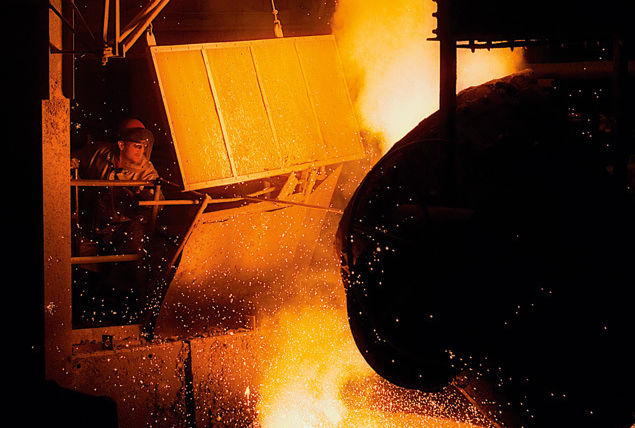Having a Blast

Image: Daniel Root
LATE ON A BLUSTERY NIGHT in November, on a catwalk inside an aging monolithic foundry in Northwest Portland, I found myself staring into the mouth of an electric arc furnace that buzzed and roiled with 36 tons of molten steel. Beside me stood the department foreman, Jerry Bailey, a grandfather in his early sixties who has spent the last 44 years of his life at Esco Corporation, which makes spare parts for steam shovels, bulldozers and other heavy machinery. Bailey’s a ruggedly handsome good-old-boy wearing a jacket, jeans, steel-toed boots and a scuffed hardhat. He smells like cigarette smoke and spends his nights tending the fires of Esco’s twin blast furnaces with the authority of Hephaestus, the smith of Greek legend who forged the magnificent armor worn by the gods.
“It’s exciting, every day, all the time,” said Bailey, who doesn’t seem like the type of guy who’s given to spontaneous displays of emotion. “Anytime you’re working with hot steel, it’s a rush. When the metal pours into the mold, it makes this whoosh, like a real strong wind. It sends a chill up and down my spine. Every time.”
Gritty yet essential jobs like Bailey’s—all told, the businesses of the Harbor Industrial District employ some 40,000—rarely get touted by City Hall leaders, who seem far more enamored with cultivating the creative class, even though the advertising, public relations and design firms that make up the city’s creative-services industry account for a mere 14,000 jobs. With this in mind, we hired photographer Daniel Root (“Heavy Metal”) to take us on a pictorial tour of Portland’s overlooked industrial heartland.
At the Esco foundry, a bone-chilling wind whipped through the factory complex, a warren of drafty metal barns spanning more than four city blocks where an army of 350 welders, crane operators and machinists went about their chores, bundled against the cold. With a roar, the furnace disgorged a stream of molten steel into a hot-tub-sized crucible, which glowed so brightly, it was like staring into the face of the sun. In an instant, the formerly frigid warehouse had become as cozy as a wood-heated cabin. Poised above the shrieking cauldron, Charlie Seaton, garbed in a heat-resistant silver protective suit, gingerly dipped a long-handled ladle into the bubbling magma. He drew out a sample and dashed across the floor, a human comet trailing a shower of liquid fire.
Up on the catwalk, Root motioned us over to show off the image of Seaton (pictured above) he’d captured with his digital camera. Two Esco old-timers joined the huddle and peered into the backlit screen. “Gee, I dunno, some people might think that looks kinda dangerous,” one worried. But to Root, that was the whole point. “You’re right, it is dangerous,” he said. “But that’s the job. This is how it happens. This is the real thing.”
TED KATAUSKAS
Editor-in-Chief
[email protected]

